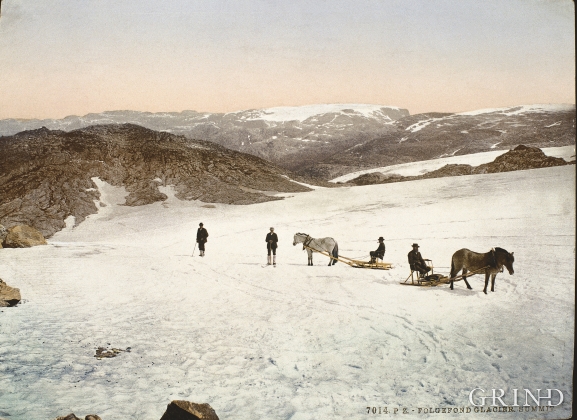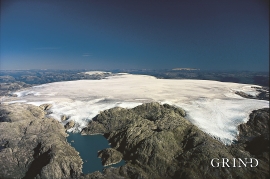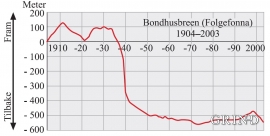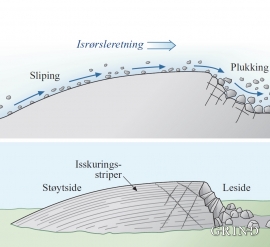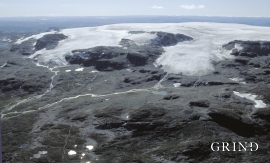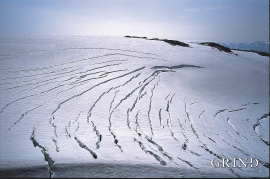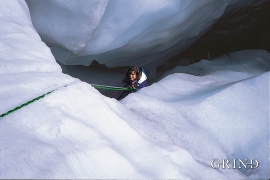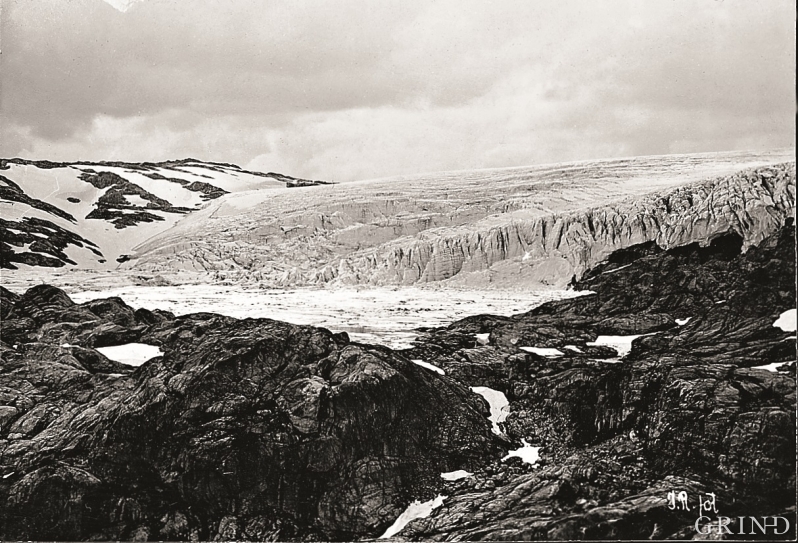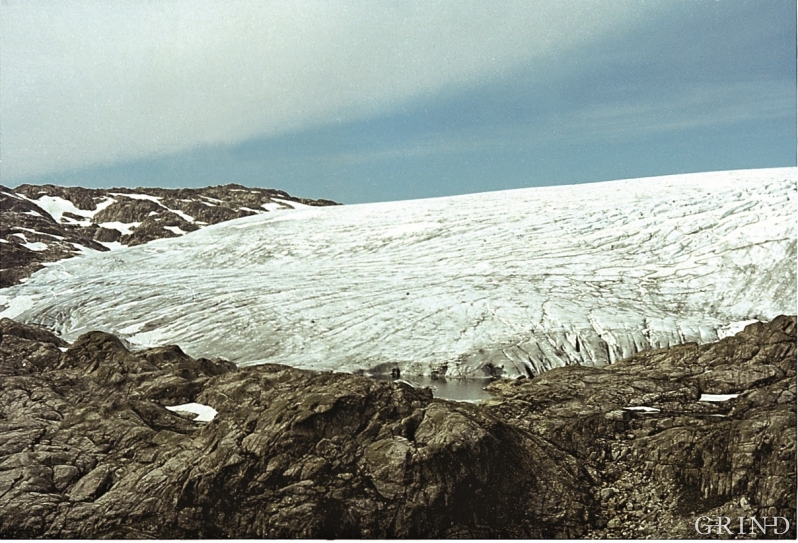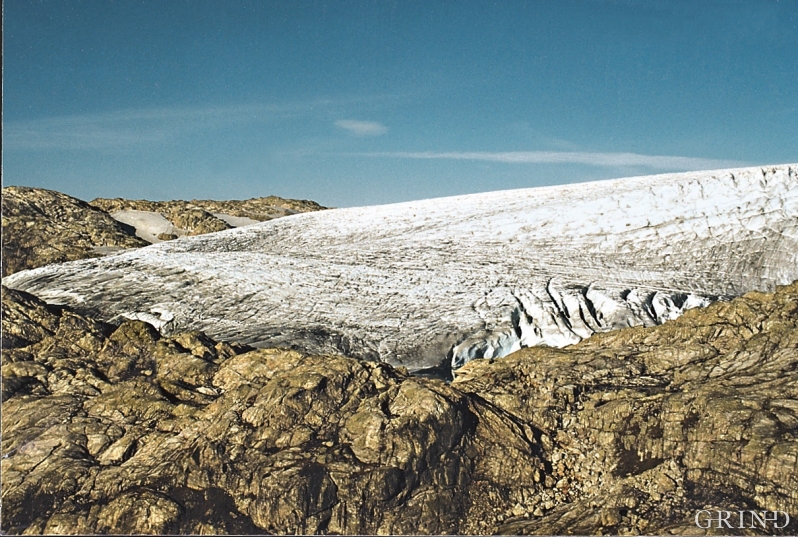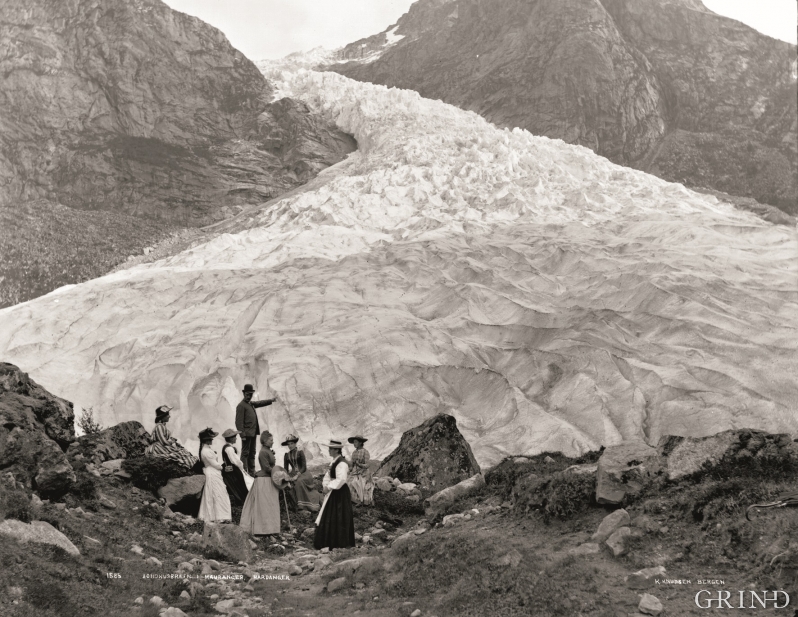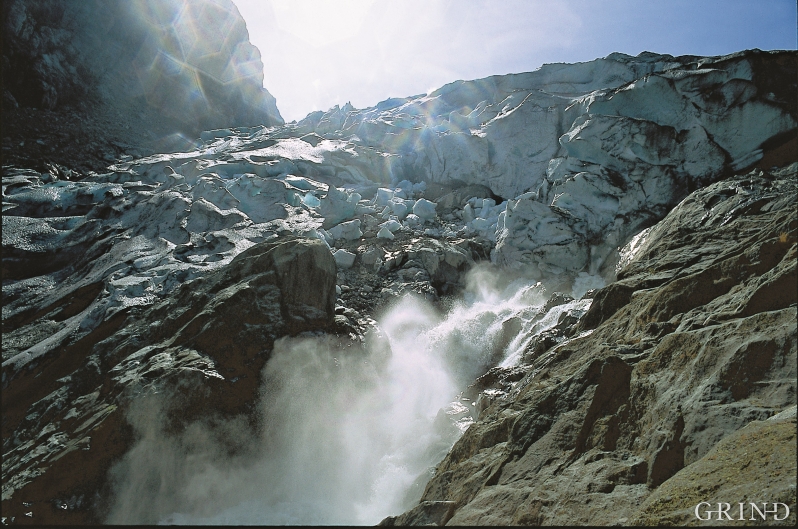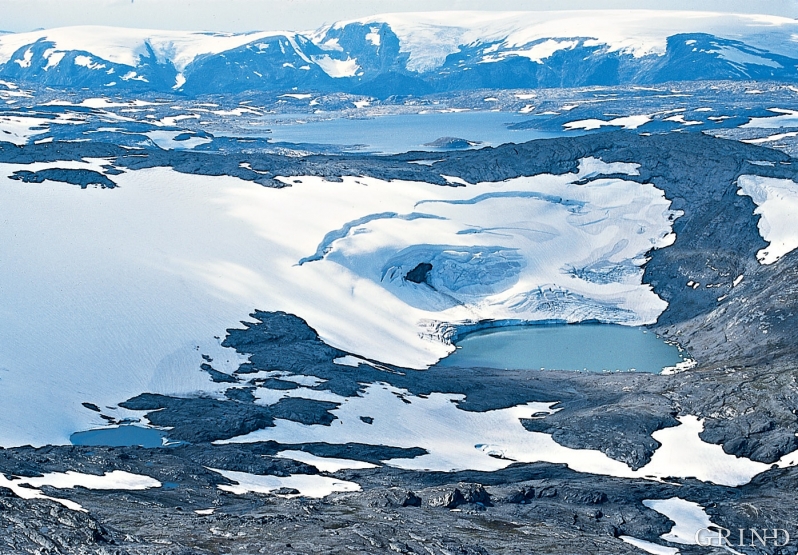Published: 28.10.2004 | Author: Atle Nesje, Svein Olaf Dahl, Arve Tvede, Jostein Bakke
Turisttransport med hestar på den søre iskappa på Folgefonna, Sørfonna. Utsyn mot nord.
Climate indicators and sculptors of landscapes
Two of Norway's - and mainland Europe's - largest glaciers, in addition to a number of smaller glaciers, lie in Hordaland. This eternal ice is easily accessible, and easy to be enchanted with. A National Day parade goes to the top of the Hardanger glacier, and Folgefonna glacier has lift assistance at the summer ski centre in Jondal.
Some of the glaciers in Hordaland seem to have a mind of their own; they often grow and recede out of sync with glaciers elsewhere in Norway. Folgefonna is especially unpredictable. Its nearness to the coast and high levels of precipitation have made Folgefonna somewhat of an oddity in glacier history.
A glacier can only be formed when the snow precipitation in winter is greater than the melting in summer. Snow and ice can nonetheless exist for years without becoming a glacier. First when the mass of ice and snow is so thick that its weight causes it to begin to glide slowly downhill, can it be called a glacier.
The climate was warmer in Scandinavia for the first thousand years after the end of the last ice age, with summer temperatures 1-2o higher than today. During this period the tree limit on the Hardanger Plateau was roughly a hundred metres higher than today. The majority, if not all of the glaciers in Norway have probably melted away one or more times. The climate became cooler again roughly 5000-6000 years ago. New glaciers formed in mountainous areas at high altitudes. Folgefonna is an exception, since this glacier did not form until another 1000 years had passed. The most pronounced glacier formation of the past 10,000 years occurred even later, however, during a period known as the "Little Ice Age" which lasted from around 1650 to 1920. Most of the glaciers in Norway were at their greatest extent during the middle of the 1700s. Again, Folgefonna's reached its maximum somewhat later - tongues from this glacier reached their greatest extent first at the end of the 1880s and then around 1930. Most of the glacial tongues in Norway receded markedly during the 1930s and 1940s, mainly as a result of the warm summers. After 1960, and especially at the end of the 1980s and beginning of the 1990s, some of the glaciers near the coast advanced, while the inland glaciers have continued to recede.
The growth of glaciers might seem strange in light of the simultaneous increase in global temperatures. The explanation is that higher temperatures cause an increase in evaporation from the North Atlantic Ocean. This increases the precipitation in West Norway, and more snow falls in the coastal mountains. The glaciers therefore grow more during the winters than the increased temperatures in summer manage to melt away.
Folgefonna
The first description of Folgefonna is found in Peder Clausøn Friis's book «Om Norriges beskrivelse» ("Studies of Norway”) from 1613. In 1752 Erich Pontoppidan called the glacier "Fuglefang", and explained the name "Fugle" (which means "bird" in English) as deriving from the birds that flew over the glacier. These birds were thought to be the souls of people who according to the Sagas lie under the glacier, as a result of God's punishment after a big snowfall.
Why is there a glacier just here? The high altitude of the mountain plateau combined with the large amount of precipitation is the reason for this glacier's formation. Moist westerly winds from the ocean were pressed upwards and then cooled off over the plateau, causing a lot of precipitation. On the east side of Folgefonna, along Sørfjord in toward Odda, there is much less precipitation. In Ullensvang the annual precipitation is only 1350 mm, whereas it is more like 3070 mm at Inner Matre on the southwest side of Folgefonna. The amount of precipitation that falls up on the plateau is greater than that which falls down by the fjord. On Blomstølskardbreen glacier on the southwestern part of Sørefonna, the precipitation is as much as 5000 mm annually in a typical year. Midtfonna and Norefonna receive about 3500 mm. Roughly 70% falls as snow and 30% as rain. The summer temperatures on Folgefonna are usually not high enough for the melting to offset the winter accumulation of snow. Thus, the glacier endures.
Its coastal location, right in the path of low pressure systems, means that Folgefonna is also affected by the climatic development of the entire region around the North Atlantic. Its access to precipitation is closely dependent on the temperature of the surface water in the ocean west of Norway, and its position in relation to the polar jet stream. The effect of ocean currents and atmospheric winds from times past can therefore be read from the record in the ice. "Foglefonna reveals nothing", is the title of Opus 151 by Geirr Tveitt (*1908-1981). If only the Hardanger composer knew what stories the ice has to tell, to those who know how to read the language of glaciers.
At our latitudes the air temperature is usually 0.6oC lower for every hundred metre increase in elevation. When the air temperature is 6oC down by the fjord, it is near freezing (0 oC) at 1000 metres above sea level. Usually it snows on the highest parts of Folgefonna when it rains in the fjords and the temperature is under 10oC. On clear days a cold wind often blows down over the glacier tongues. This is caused by the cooling of air over the glacier. The air gets heavier, and a breeze blows down the valleys. When the air warms up further down in the valley, it rises again. In this way the glacier creates its own wind, a so-called "katabatic" wind.
The glacial rivers are very profitable for hydroelectric-power developers. In spring and summer months with little precipitation, these rivers can nonetheless have a large output caused by melting, which can even out the production capacity. Several of the rivers running from Foglefonna are used for electricity production. Sunnhorland Kraftlag has its facility Blåelvi on the south side of Foglefonna (Blåfalli). The rivers from Bondhusbreen glacier and northwards to Jondal are used by Statkraft in the Folgefonna facility Mauranger.
Studies of Folgefonna
The first one to write a scientific paper about Foglefonna was Sjur A. Sexe (1808-1888) from Sekse in Ullensvang. In 1864, "Om Sneebræen Folgefon" (= "On the Glacier Folgefonna") was published in Kristiania. He discussed the glacial melting in summer, the temperature conditions on the glacier, the creation of crevasses and ice movement. At the end of the paper there is a colour map of Folgefonna Peninsula (Fig. XX) which he made especially for the publication. Sexe later became a professor in "mountain-building and physical geography" at the University of Kristiania. Also of significant scientific interest - and an important historical document - are the photographs of the Buarbreen and Bondhusbreen glaciers taken by K. Knutsen from Tokheim in Odda about 1870 and until the beginning of the 1900s.
In 1900 Johan Rekstad began taking measurements of the front position of the Bondhusbreen and Buarbreen glaciers, and in 1905 he published "Observations from Folgefonna's glaciers". In this scientific manuscript there are several photos of the Blomstølskardbreen glacier on the south side of Folgefonna. These photos show that this part of Folgefonna had advanced considerably after 1904.
In the 1960s Norway's Water Resources and Energy Directorate (NVE) began mapping the water resources around Folgefonna, and in 1963 they started taking systematic measurements both in the waterways and on the glacier. On the northern part of Søndre Folgefonna the snow accumulation was measured in the spring and the melting during the summer. The difference between the accumulation and melting is called the glacier's mass balance (T84). Mass balance measurements were carried out on Blomstølskardbreen glacier between 1970 and 1977. Daily observations were carried out on Holmaskjer (1565 m.a.s.) and at Fonnabu (1450 m.a.s) up until 1975. In addition the ice thickness was measured along a profile from the bottom of Gråfjellbreen glacier over to the ice edge toward Buardalen. The objective was to find out if it was possible to lead water from Buardalen over to Maruanger. (Fig.X Tvede lagar). The melting boreholes on Bondhusbreen glacier that were made in connection with the search for water for electricity production showed that the glacier was 150-200 metres thick at the drill site. It is estimated that Folgefonna could be 300-400 metres at its thickest. If the thickness is 150 metres on average, then Folgefonna contains a volume of about 30 cubic kilometres of ice.
Glacier measurements were carried out on Folgefonna between 1981 and 1994. During the summer of 1994 measurements were started up again because the river from Blomstølskardbreen glacier abruptly created a new course, away from Sunnhorland Kraftlag's inlet and over to Mosneselva River (R246.) The measurements resulted in a new map being made of the glacier tongues along the south side of Folgefonna. The map shows how the glacier surface has varied between 1959 and 1995.
Ice movements on Folgefonna were measured at Gråfjellbreen and on Breidablikkbreen glaciers in the mid 1960s. The ice moved at a speed of only 1-2 metres per year near the glacier tongue and about 20 metres at its equilibrium line (see frame). At Blomstølskardbreen glacier the annual ice movement at the equilibrium line was considerably greater: 50-60 metres per year. The fastest ice movement was measured at Bondhusbreen glacier. At the top of the glacier the ice moved 100-150 metres per year.
How old is Folgefonna?
Recent investigations have shown that Folgefonna, since the continental ice sheet melted away, has behaved differently than the other glaciers in southern Norway. Right after the last Ice Age Folgefonna made several large advances. No other advances from that time are yet shown for any other glacier in Norway. The last large advance before the glacier melted away occurred roughly 8,000 years ago. After that, Folgefonna disappeared for several thousands of years. The first trace of Folgefonna as we know her today came about 2500 years ago. The glacier grew quickly and blocked off the Jukladalen valley north of Nordfonna, among others, which caused a big flood down the valley comprising the Jondal water system. This occurred again about 1,000 years ago, before the glacier began to recede as a result of warmer summers with less snow in the winters since that time. The largest and most extensive period of glacier growth in Foglefonna's recent history occurred during the "Little Ice Age", a generally colder period characterized by changing weather with both warmer and colder summers than in the present time. The historical sources - most from the easily accessible glaciers in Bondhusdalen and Buerdalen - show that changes in Folgefonna occurred later than in the other glaciers in West Norway. The southernmost part of the glacier had its maximum extent as late as around 1940.
Little is known about the changes in the Bondhusbreen glacier (R284) before 1850, but it grew dramatically in size during the early 1860s. When the glacier was at its largest, in the mid 1870s, it mowed down the birch forest. It remained quite large during the 1870s and 1880s, but then varied in size up until about 1911. After that it began to melt back, until about 1921. Between 1922 and 1932 it advanced again, reaching about the same size as it had been during the mid 1870s. The outer and inner moraine ridges on the plateau below Bondhusbreen glacier are from the middle of the 1870s and roughly 1930. During the 1930s and 1940s the glacier tongue melted back up the steep bare rock slopes, which are below the present day front. There was little change over the next 30 years. At the beginning of the 1990s the glacier advanced again as a result of much precipitation in winter at the end of the 1980s and beginning of the1990s. Since 1999 it has receded back again.
Historical sources from the 1850s report that the Buarbreen glacier tongue (R510) was not visible from Buer and that the glacier was in retreat in 1860, but that during the previous decade there had been a marked advance. Around 1870 the glacier started to grow, and eyewitness reports say that the growth was dramatic. The ice ploughed over old pasture land and destroyed a mountain farm and old forest. The glacial advance ceased in the 1880's, but a new advance around 1890 resulted in a maximum
in 1893. After this, the glacier began to retreat, but advanced again in the 1930s. At the end of the 1930s and in the 1940s it receded markedly. Buerbreen glacier grew during the 1990s, but receded in 1999.
Hardanger Glacier
The circularly-shaped Hardanger glacier is Norway's sixth largest glacier. In southern Norway, only Jostedalsbreen and Søndre Folgefonna glaciers are larger. The best known tongues of the glaciers are Rembesdalsskåki in the southwest (R517), Austre- and Vestre Leirbotnskåki in the southeast, and Blåisen and Midtdalsbreen toward Finse in the northwest. Seismic measurements show that the maximum ice thickness is between 300 and 400 metres.
Hardangerjøkulen glacier is one of the best studied glaciers in Southern Norway, especially as to how it has varied over the past 10,000 years. Traditionally, end- and side-moraines have been used to reconstruct the size of the glacier in the past. The biggest problem with such use of moraines as measures of ice variation is that the glacial advance that extends furthest tends to destroy the moraines from earlier advances that did not reach as far. The largest glacial advance in our parts occurred 10 000 years ago, as the Ice Age was drawing to a close. The next largest occurred during the "Little Ice Age" in the mid 1700s; then, the glacier tongue extended from Middalsbreen and Blåisen glaciers two kilometres further than at the present time. The moraine ridges that mark these advances are clearly visible many places in the terrain. All end- and side-moraines from glacial advances in the long period between would have been destroyed by the advance during the "Little Ice Age". Therefore, alternative methods have to be used to find out how the Hardangerjøkulen glacier has varied through most of the period since the last Ice Age.
As a glacier erodes the bedrock it moves across, it produces a fine "glacial flour". It is this glacial flour that gives the glacial rivers their characteristic grey-green colour. If you see a river with this colour, you know that it is fed by a glacier. Similarly, deposits of glacial flour in bogs and in sediment at the bottom of lakes show that there probably was a glacier above them at the time of deposition.
At Finse there is a boggy basin and water that, dependent on how large the glacier has been in the past, has deposited glacial flour. When the glacier was small, only organic sediment would have been deposited in these basins. When the glacier was bigger, glacier flour would be laid down. By dating such changes one can reconstruct past variations in the size of the Hardangerjøkulen glacier.
The Hardangerjøkulen glacier disappeared entirely from about 8000 to 7000 years ago. Long before the glacier melted away, perhaps over a thousand years before, pine forest grew on Hardangervidda plateau. (R 521) Regardless of whether the climate was warm enough for pine trees, the winter precipitation was high enough for the year-round ice to exist side by side with a pine forest as its neighbour. Since that time the glacier came and went several times, but from about 4000 years ago until Viking times it grew steadily until it reached its present day size. The relatively even growth was interrupted only by the dramatic increase in size during the "Little Ice Age".
The grey-green map-lichen has been used as an indicator for reconstructing the melting of the glacier since the "Little Ice Age". When rocks stick out from the glacier, lichen begins to grow on them. As the glacier advanced again, the lichen would be scraped away. Map lichen grows slowly out from the centre, roughly a few tenths of a millimetre per year. (T150). By studying the size of the map lichen on the rocks, one can date the moraine ridges from different glacier tongues relative to each other. At the Hardangerjøkulen glacier the map lichen from the "Little Ice Age" is roughly 9-22 cm in diameter - and has become gradually smaller in towards the present day glacier front. (see frame)
The mass balance measurements at Rembesdalsskåki carried out by Norway's Water Resources and Energy Directorate show that the glacier increased in size from 1963 to 2000. When we distribute the increase in size over the whole glacier, it corresponds to a layer of water that is 6 metres thick. During the 1990s the measurements at Blåisen and Midtdalsvereen showed that these arms of the glacier have advanced forward by about 25 metres. During the same period the Rambesdalsskåki glacier advanced roughly 50 metres.
The small glaciers in inner Hardanger and on Hardangervidda Plateau
Around the inner parts of Hardanger Fjord and the western parts of Hardanger Plateau, there are several smaller glaciers in addition to the larger Hardangerjøkulen glacier. One of the best known is Såteskavlen, the glaciers on Vassfjøra, Vossaskavlen, Osaskavlen and Omnsbreen on the north side of Hardanger Fjord. From north to south on the Hardangervidda Plateau the glaciers are called Dyrafonn, Tresfonn, Solfonn, Storfonn, Nupsfonn and Breifonn.
The glaciers on Hardangervidda Plateau have receded markedly after 1930. Their melting back is easy to see when old maps are compared to arial photos taken in 1960 and 1994. Judging from the old maps, both Omnsbreen and Nupsfonn glaciers formed a continuous glacier 70-80 years ago. Omnsbreem glacier just north of Finse, the only one of the smaller glaciers to have been studied carefully, had an area of roughly 13 square kilometres in the 1930s. Today it has essentially melted away. Nupsfonn is more like a number of other smaller glaciers whose remains are still visible between protruding mountain peaks. Tresfonn has become a cirque glacier. The smaller glaciers on Hardangervidda Plateau are thought to be only a few tens of metres thick.
From snow to ice
Dry, newfallen snow normally has a density of around 0.1 g/cm3. When snow is transported further by wind, it gets packed even tighter, to around 0.3 g/cm3. Further deposition, compressing and re-freezing of meltwater increase the density to about 0.55 g/cm3. Snow that survives one summer has roughly this density and is called firn.
The subsequent increase occurs through a process whereby larger ice crystals "eat up" smaller ones. The density increases more slowly through this process, but a steady supply of water down in the firn layer leads to the eventual formation of a layer of ice. At around 0.8 g/cm3 the firn is almost airtight and becomes glacier ice. Any remaining air gradually collects as air bubbles in the ice. The table under shows the weight and pore volume in different types of snow and ice.
WEIGHT (kg/m3) PORE VOLUME (%)
"Feather" snow 10-30 99-97
Normal new snow 30-60 97-93
Drifted snow (packed) 100-300 89-67
Overflow snow 200-300 78-67
Granular snow 200-400 78-56
Firn 300-800 65-20
Glacier ice 800-900 30-5
Ice 917 0
The time it takes for firn to become glacier ice varies a lot, and is mainly determined by the summer temperature. On glaciers nearer the coast this transformation can take as little as 5-6 years.
Folgefonna
Folgefonna is a collective name for three glaciers: Sørefonna covers an area of 160 square kilometres, Midtfonna 11 square kilometres and Norefonna 26 square kilometres, a total of 205 square kilometres. The highest point on Folgefonna is 1662 metres above sea level and lies just east of Fonnabu on Sørefonna. The lowest point is the glacier front facing Bondhusbreen, at roughly 480 metres above sea level.
Profil frå søraust til nordvest av istjukna og høgda på fjelloverflata frå Buarbreen til Gråfjellsbreen. Isen er om lag 250 meter tjukk på det meste. (NGU/Arve Tvede/Sverre Mo)
A glacier's mass balance
The mass balance of a glacier is a result of changes in the rate of melting (ablation) and accumulation which in turn causes volume changes on the glacier. These conditions have also been referred to as the glacier's "budget". The glacier's mass balance was generally calculated annually, where accumulation represented the collective "income" and ablation the collective "output". The net balance could be positive or negative, according to whether the ablation was greater or less than the accumulation. The balance year – or the budget year – goes from the end of the melting season one year to the end of the melting season the following year. The accumulation season usually lasts from the 1st of October to the 30th of April (7 months), while the ablation season lasts from the 1st of May until the 30th of September (5 months).
The mass balance on Norwegian glaciers has usually been measured by inserting a stake into the glacier at the start of the accumulation season. The amount of snow is converted to water volume by taking a measurement of the snow density. In addition to the meteorological factors, the topography on the glacier surface influences the snow distribution, since snow generally blows off of the peaks and collects in the valleys on the glacier.
The equilibrium line on the glacier is the zone where the accumulation is equal to the ablation. The equilibrium line will be high up on the glacier during years when the mass balance is negative, and will be low down in years with a positive mass balance. The height of the equilibrium line varies with the climatic conditions, where summer temperature and winter precipitation are the two most important factors. Since winter precipitation is greatest in the southern part of Folgefonna, the equilibrium line can be as low as 1350 metres above sea level in this part of the glacier. North of Buerdalen the equilibrium line increases to 1500 metres above sea level.
Change in the position of the front of the glacier is an adjustment to change in accumulation and ablation in order to achieve a climatic equilibrium. The front of the glacier is the part that most visibly reacts to changes in the mass balance. Front variations are the result of complex short- and longterm climatic fluctuations. There is a certain lag time between an eventual surplus or deficit in the mass balance, which translates into a delay in the reaction time for changes in the position of the glacier front. The figure shows the variations in the front of the Bondhusbreen glacier from 1900 to the late 1980s.
The glacier shapes the ground layer
Stone and rock fragments of different sizes get frozen into the bottom of the glacier. These fragments acts as a kind of sandpaper on the bedrock under the ice. The removal of material (erosion) consists of grinding and plucking.
The process of grinding leaves behind glacial striations. The striations are formed by fragments of rock in the contact zone between the ice and bedrock beneath. The direction of the striations shows the direction of glacier movement. These glacial striations cross each other many places, indicating that the direction of past ice movement changed over time.
The ice can loosen large blocks, most often along cracks in the bedrock, and transport these long distances. When moving ice encroaches on rocky peaks the pressure on the ice increases, which also increases the temperature in the ice. When the temperature reaches the pressure melting point, which is the temperature under which the ice melts due to the amount of pressure, the ice will begin to melt. On the lee side of the rocky peak the pressure falls and the temperature also goes down so that the water in the cracks freezes to ice. Some of the stone blocks that have been loosened by the freezing and thawing of ice get transported in the ice. This is known as "plucking". These rocks then contribute to the scouring at the next point of contact. The asymmetric form of the resulting rock formations shows clearly which way the ice has travelled.
Hardangerjøkulen
Hardangerjøkulen is a continuous glacier with an area of 73 km2. The glacier stretches from its highest point at 1850 m down to 1050 m at the front of Rembesdalsskåki, toward the southwest.
Dei øvste kurvene syner årlege variasjonar i massebalansen (sjå definisjonar i «Massebalansen for brear») vinter og sommar, og nettobalansen for Rembesdalsskåka i perioden 1960–2000 omrekna i vasstjukkleik. Den nedste kurva syner netto oppsamla masse på breen for heile denne perioden. (Atle Nesje/Sverre Mo)
Brefrontvariasjonar på nordsida av Hardangerjøkulen gjennom dei siste 10 000 åra. (Atle Nesje/Svein Olaf Dahl/Sverre Mo)
Crevasses
The movement of the ice causes deformation, pressure and stretching. Where the stretch-forces are greatest the ice breaks up, and where the thrust-forces dominate, the ice piles up. Deeper down in the glacier the overlying pressure is usually greater than the stretch-forces. This explains why crevasses are seldom found deeper than 20-30 metres, though there are exceptions where glaciers flow over convex bedrock and down a steep slope. An example of this can be seen at Blåisen (="Blue Glacier") at Finse, where the depth of the crevasses can reach as much as 40 metres.
- Andersen, B. G. 2000. Istider i Norge. Landskap formet av istidens breer. Universitetsforlaget.
- Hagen, J. O.; Liestøl, O.; Sollid, J. L.; Wold, B.; Østrem, G. 1993. Subglacial investigations at Bondhusbreen, Folgefonni, Norway. Norsk Geografisk Tidskrift 47/3:117–162.
- Nesje, A. 1995. Brelære. Høyskoleforlaget 1995.
- Rekstad, J. 1905. Iagttagelser fra Folgefonnens bræer. Norges Geologiske Undersøkelsers Årbok.
- Sexe, S. A. 1864. Om Sneebræen Folgefond. Universitetsprogram for annet halvår 1864. Christiania.
- Tvede, A. M. 1973. Folgefonni – en glasiologisk avviker. Naturen 97:11–15.
- Tvede, A. M. 1989. Floods caused by a glacier-dammed lake at the Folgefonni ice cap, Norway. Annals of Glaciology no 13.
- Østrem, G.; Dale Selvig, K.; Tandberg, K. 1988. Atlas over breer i Sør-Norge. Noregs vassdrags- og energiverk, Hydrologisk avdeling, Meddelelse 61.

